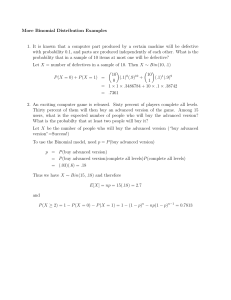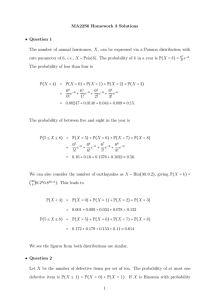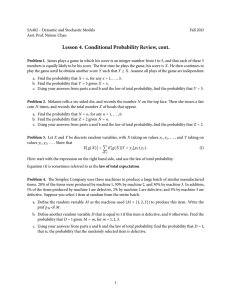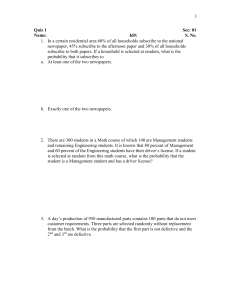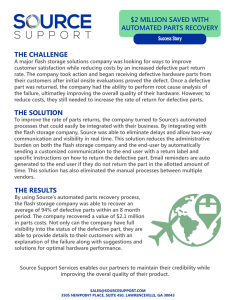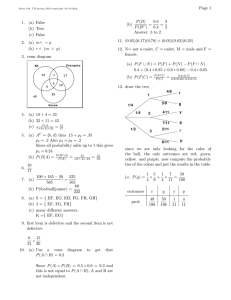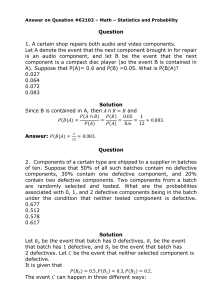Homework 1 Solutions
advertisement
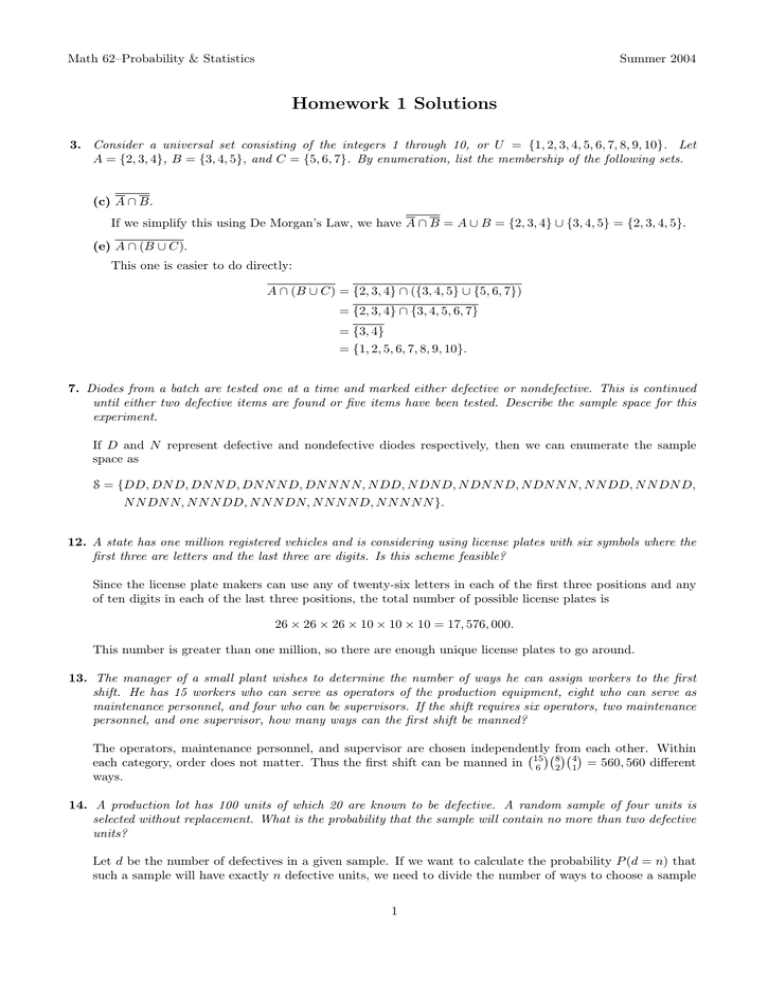
Math 62–Probability & Statistics
Summer 2004
Homework 1 Solutions
3. Consider a universal set consisting of the integers 1 through 10, or U = {1, 2, 3, 4, 5, 6, 7, 8, 9, 10}. Let
A = {2, 3, 4}, B = {3, 4, 5}, and C = {5, 6, 7}. By enumeration, list the membership of the following sets.
(c) A ∩ B.
If we simplify this using De Morgan’s Law, we have A ∩ B = A ∪ B = {2, 3, 4} ∪ {3, 4, 5} = {2, 3, 4, 5}.
(e) A ∩ (B ∪ C).
This one is easier to do directly:
A ∩ (B ∪ C) = {2, 3, 4} ∩ ({3, 4, 5} ∪ {5, 6, 7})
= {2, 3, 4} ∩ {3, 4, 5, 6, 7}
= {3, 4}
= {1, 2, 5, 6, 7, 8, 9, 10}.
7. Diodes from a batch are tested one at a time and marked either defective or nondefective. This is continued
until either two defective items are found or five items have been tested. Describe the sample space for this
experiment.
If D and N represent defective and nondefective diodes respectively, then we can enumerate the sample
space as
S = {DD, DN D, DN N D, DN N N D, DN N N N, N DD, N DN D, N DN N D, N DN N N, N N DD, N N DN D,
N N DN N, N N N DD, N N N DN, N N N N D, N N N N N }.
12. A state has one million registered vehicles and is considering using license plates with six symbols where the
first three are letters and the last three are digits. Is this scheme feasible?
Since the license plate makers can use any of twenty-six letters in each of the first three positions and any
of ten digits in each of the last three positions, the total number of possible license plates is
26 × 26 × 26 × 10 × 10 × 10 = 17, 576, 000.
This number is greater than one million, so there are enough unique license plates to go around.
13. The manager of a small plant wishes to determine the number of ways he can assign workers to the first
shift. He has 15 workers who can serve as operators of the production equipment, eight who can serve as
maintenance personnel, and four who can be supervisors. If the shift requires six operators, two maintenance
personnel, and one supervisor, how many ways can the first shift be manned?
The operators, maintenance personnel, and supervisor are chosen independently
from
each other. Within
8 4
each category, order does not matter. Thus the first shift can be manned in 15
6
2 1 = 560, 560 different
ways.
14. A production lot has 100 units of which 20 are known to be defective. A random sample of four units is
selected without replacement. What is the probability that the sample will contain no more than two defective
units?
Let d be the number of defectives in a given sample. If we want to calculate the probability P (d = n) that
such a sample will have exactly n defective units, we need to divide the number of ways to choose a sample
1
with n defectives by the total number of ways to choose any sample. There are 20
n ways to select the n
100
defective units, 4−n
ways to select the (4 − n) good units, and 100
ways to select any sample of 4 units.
4
Thus
P (d = n) =
20
n
100
4−n
100
4
.
Since we want the probability that the sample will contain no more than two defective units, we simply sum
the probabilities of there being exactly zero, one, or two defectives in the sample, which gives us
100
100
20 100
+ 20
+ 20
0
4
1
3
2
2
.
P (d ≤ 2) = P (d = 0) + P (d = 1) + P (d = 2) =
100
4
16. In a plastics plant 12 pipes empty different chemicals into a mixing vat. Each pipe has a five-position gauge
that measures the rate of flow into the vat. One day, while experimenting with various mixtures, a solution
is obtained that emits a poisonous gas. The settings on the gauges were not recorded. What is the probability
of obtaining this same solution when randomly experimenting again?
There are five settings on each of 12 independent gauges, which means there are 512 settings for the system
as a whole. Only one of these will yield the same solution, so the probability is 1/(512 ).
18. By accident, a chemist combined two laboratory substances that yielded a desirable product. Unfortunately,
her assistant did not record the names of the ingredients. There are forty substances available in the lab. If
the two in question must be located by successive trial-and-error experiments, what is the maximum number
of tests that might be made?
Order doesn’t matter here, so there are
40
2
= 780 possible two-substance combinations.
19. Suppose, in the previous problem, a known catalyst was used in the first accidental reaction. Because of this,
the order in which the ingredients are mixed is now important. What is the maximum number of tests that
might be made?
In this case, order clearly does matter, so we must use permutations instead. We can choose any of the 40
chemicals for the first reactant and any of the remaining 39 for the second, so there are (40)2 = 40 · 39 = 1560
different ways to mix the chemicals.
2
